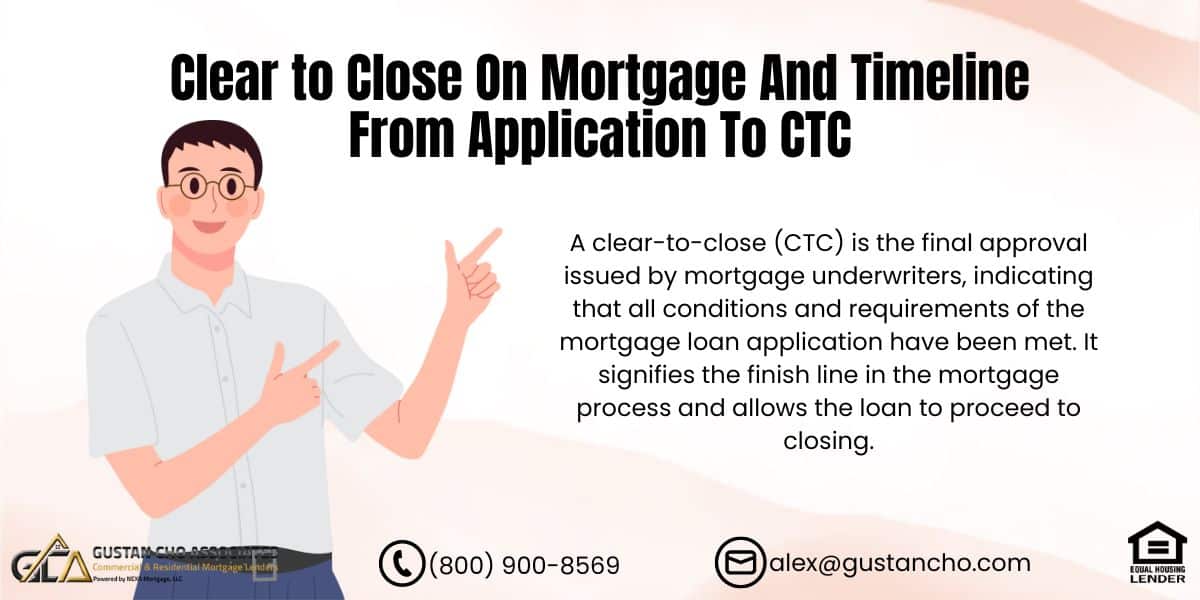In this blog post, we’ll explore the process of achieving a clear-to-close mortgage and the timeline from the initial loan application to this critical stage. But what exactly does “clear-to-close” mean in the mortgage realm?
A clear-to-close mortgage (CTC) represents the culmination of the mortgage process. It’s the point at which the mortgage lender has thoroughly reviewed and processed the mortgage loan application. The status of being approved for a mortgage is critical and requires careful assessment by underwriters. The underwriter thoroughly examines the mortgage application to ensure all requested conditions are met before reaching this crucial stage.
Documents Reviewed By Mortgage Underwriter Prior To CTC
Before submission to the mortgage underwriter, the processor meticulously reviews all documents to ensure completeness. The underwriter promptly returns any incomplete documents to the mortgage processor, as they are a leading cause of delays in the mortgage process.
The following documents undergo thorough scrutiny by the mortgage underwriter before the issuance of a Clear to Close On Mortgage (CTC):
- Updated bank statements
- Paycheck stubs with recent updates
- Verification of employment’s final confirmation
Some mortgage lenders implement a quality control department through which every mortgage application must pass before a CTC can be granted. This department includes a quality control mortgage loan underwriter tasked with reviewing the original underwriter’s work. This meticulous review ensures the absence of errors and the marketability of the mortgage loan to secondary entities like Fannie Mae or Freddie Mac.
Upon the issuance of a CTC, the mortgage lender proceeds to prepare the necessary documentation. A CTC signifies that funds can be wired once final figures receive approval, facilitating the closure of the mortgage loan. All documentation must be complete, verified, and compliant with government loan insurance requirements.
Conventional loans undergo additional scrutiny to ensure compliance with Fannie Mae and/or Freddie Mac Mortgage Guidelines, as they are checked for marketability in the secondary market.
FHA-backed mortgage loans require more items than conventional loans. The following paragraphs will explain these requirements in detail. Speak With Our Loan Officer for Mortgage Loans
What are the 4 Steps in the Closing Process in Order?
The final stage in a mortgage loan transaction is the mortgage closing process, often referred to as the “clear to close on mortgage.” It occurs after the buyer and seller have agreed upon the property sale, and the buyer has secured financing from a lender. This process encompasses several crucial activities:
Title Search and Title Insurance
Before a property sale, a title search is necessary to validate the seller’s legal right to sell and to uncover any claims or liens. Title insurance safeguards the buyer and lender against any title defects missed during the search, offering both peace of mind and financial security.
Preparation of Closing Documents
Upon confirming a clear title and receiving a “clear to close on mortgage,” the closing documents are prepared. These include final loan agreements, the deed transferring property ownership, closing disclosures, and any other necessary paperwork.
Closing Appointment
On the agreed-upon closing date, the buyer, seller, and relevant parties (such as real estate agents, attorneys, and a closing agent or escrow officer) convene to sign the closing documents and finalize the transaction. Typically, the buyer settles any remaining closing costs and down payment while the seller transfers property ownership.
Funding and Recording
Following the signing of necessary documents and the transfer of funds, the closing agent or escrow officer ensures all closing costs are settled. Subsequently, the transfer of ownership becomes official, marking the closure of the transaction. The closing agent coordinates with appropriate parties to record the deed and mortgage documents with the county or municipal land records office.
Real estate transactions may vary in steps depending on location and terms agreed upon.
The Federal Housing Administration
Before submitting to the mortgage underwriter, the processor reviews all documents to ensure completeness. The underwriter promptly returns any incomplete documents to the mortgage processor, as they cause delays in the mortgage process.
The following documents undergo thorough scrutiny by the mortgage underwriter before the issuance of a Clear to Close On Mortgage (CTC):
- Updated bank statements
- Paycheck stubs with recent updates
- Verification of employment’s final confirmation
Some mortgage lenders implement a quality control department through which every mortgage application must pass before a CTC can be granted. This department includes a quality control mortgage loan underwriter tasked with reviewing the original underwriter’s work. This meticulous review ensures the absence of errors and the marketability of the mortgage loan to secondary entities like Fannie Mae or Freddie Mac.
Upon the issuance of a CTC, the mortgage lender proceeds to prepare the necessary documentation. A CTC signifies that funds can be wired once final figures receive approval, facilitating the closure of the mortgage loan. All documentation must be complete, verified, and compliant with government loan insurance requirements.
Conventional loans undergo additional scrutiny to ensure compliance with Fannie Mae and/or Freddie Mac Mortgage Guidelines, as they are checked for marketability in the secondary market. FHA-backed mortgage loans require more items than conventional loans. The following paragraphs will explain these requirements in detail.
HUD Agency Mortgage Guidelines
All mortgage lenders must ensure that every mortgage loan application meets the guidelines set by HUD for FHA loan insurance, ensuring protection in the event of borrower default. Despite misconceptions, some home sellers may hesitate to sell to FHA-approved buyers due to perceived differences in stringency between FHA and conventional mortgages, especially regarding property appraisals.
However, the reality is different. FHA-approved buyers undergo an FHA appraisal for the subject property, while conventional buyers require a conventional appraisal. The main distinction between an FHA and a conventional appraisal is the emphasis on safety and security. This process remains consistent regardless of the Clear to Close On Mortgage status.
Underwriting FHA Versus Conventional Appraisals By Mortgage Underwriters
FHA and conventional appraisals must ensure the property is habitable, with all mechanical systems functioning and utilities operational during the home appraisal process. FHA mortgage lenders follow the same documentation requirements as conventional lenders, which is essential for achieving a Clear Close on a Mortgage.
This includes providing complete documents such as two years of tax returns, W-2s, 60 days of bank statements, a 2-year employment and residence history, and other relevant paperwork for the mortgage application.
Processing and underwriting procedures are similar for both mortgage loan programs, with both FHA and conventional lenders mandating IRS Form 4506T tax verification and employment verification from the current employer. Additionally, both require a two-year seasoning requirement to consider part-time, overtime, and bonus income in the Clear to Close On Mortgage process. Talk to our experts for mortgage loans
Final Conditions For Clear To Close On Mortgage
Mortgage underwriters will require a final verbal verification of employment and final verification of funds prior to issuing Clear To Close On Mortgage. Updated bank statements may be required by borrowers. Final verbal verification of employment will be done by the mortgage underwriter prior to Clear To Close On Mortgage.
Once the mortgage underwriter feels comfortable that all conditions have been met, the mortgage underwriter will issue a clear to close which means that they are ready to fund the loan. Once a clear to close has been issued, the lender will then prepare docs and wire the funds to the title company.
Mortgage Process And Clear To Close On Mortgage
What happens after clear to close? The mortgage process and clear to close process timeline are the same for both FHA and Conventional Loans as well as other loan programs. Many home sellers are worried about clear to close on the mortgage process timeline. Most mortgage loans should close in 30 days.
FHA loans are one of the most popular mortgage loan programs in today’s market and many times is easier to get an FHA loan cleared to close than conventional loans. The reason being is that FHA guidelines have much lax debt to income ratio caps than conventional loan programs.
Private Mortgage Insurance Guidelines On Conventional Loans
Conventional Borrowers with less than 20% down payment require private mortgage insurance like FHA MIP. Private Mortgage Insurance varies on borrowers’ credit and income profile and may take time to get PMI approved. FHA has a maximum of 46.9% front-end DTI and 56.9% back-end debt-to-income ratio requirements whereas conventional mortgage loan programs have a cap on debt-to-income ratios at 50%.
If a conventional loan borrower has a slight increase on a homeowner insurance policy and that home loan borrower is on the 50% debt to income ratio cap, that slight increase can blow the deal. This is because they went over the 50% debt to income ratio cap. With FHA loan programs, borrowers have up to 56.9% and plus, with FHA loans, borrowers can have non-occupant co-borrowers as well as 100% gift funds.
How Long Does it Take From Clear to Close to Closing?
The duration between “clear to close” and the actual closing can vary, depending on various factors. These factors include the transaction’s unique circumstances, the involved parties’ efficiency, and any potential delays or complications that may arise. However, a typical real estate transaction in the United States can take anywhere from a few days to a few weeks from the time a “clear to close” is issued by the lender to the actual closing date.
“Clear to close” means that all of the lender’s conditions and requirements have been met, and the lender is ready to finalize the loan and proceed with the closing process. Once the clear to close is issued, the parties involved usually coordinate the final steps, such as scheduling the closing appointment, preparing the necessary documents, and arranging to transfer funds.
The time between clear to close and closing can also be affected by factors such as the availability of the parties involved, any necessary inspections or appraisals, and any last-minute negotiations or adjustments to the terms of the sale. It’s essential to stay in communication with your real estate agent, lender, and any other relevant parties to ensure a smooth closing process. Click here to get the more detail about Clear to close
When Can Mortgage Close After CTC?
Due to the new TRID Mortgage Guidelines, once a CTC is issued, there needs to be a three-day waiting period before a loan can close. Just because a clear to close has been issued does not mean that the closing is guaranteed. Up to the date of the closing, borrowers should not do the following:
- Apply for new credit
- Shop for new furniture
- Make irregular deposits or withdraw funds from bank accounts
- Quit their jobs
- Be late on payments
Lenders can pull credit up to the date of closing and may perform a final Verification of Employment, Verification of Deposit, or other QC control up to that date.
What is the Final Step in the Closing Process?
The final step in the closing process is recording necessary documents with the government office. This step officially establishes the transfer of ownership and any associated liens on the property. After recording, the closing agent provides a closing statement detailing all financial transactions.
Qualifying For Mortgage With Direct Lender With No Overlays
Home Buyers or homeowners needing to qualify for a mortgage with a mortgage company licensed in multiple states with no lender overlays can contact us at Gustan Cho Associates at 800-900-8569 or text us for a faster response. Or email us at gcho@gustancho.com. The team at Gustan Cho Associates is available 7 days a week, evenings, weekends, and holidays.
FAQ – Clear to Close On Mortgage And Timeline From Application To CTC
1. What does “clear to close” mean in the mortgage process? A clear-to-close (CTC) is the final approval issued by mortgage underwriters, indicating that all conditions and requirements of the mortgage loan application have been met. It signifies the finish line in the mortgage process and allows the loan to proceed to closing.
2. What documents are reviewed by mortgage underwriters before issuing a clear to close? Before issuing a clear to close, mortgage underwriters thoroughly review documents such as updated bank statements, paycheck stubs, and final employment verification to ensure all requirements are satisfied. Incomplete documents may cause delays in the process.
3. What happens after a clear to close is issued? After a clear to close is issued, the mortgage lender prepares the necessary documents for closing and coordinates the transfer of funds. Once final figures are approved, funds can be wired, and the mortgage loan can close.
4. How long does it take from clear to close to closing? The duration between clear to close and closing varies depending on transaction complexity and parties’ efficiency. It can typically range from a few days to a few weeks.
5. What is the final step in the closing process? The final step in the closing process involves recording necessary documents with the government office and officially establishing the transfer of ownership and any associated liens on the property.
6. Can additional documents be required after issuing a clear to close? Yes, mortgage underwriters can request additional documents or verification even after issuing a clear to close. This may occur if the borrower’s financial situation changes or other unforeseen circumstances occur.
7. What should borrowers avoid doing between clear to close and closing? Borrowers should avoid making major financial changes, such as applying for new credit, making large purchases, or changing jobs, as these actions can impact their mortgage approval and delay the closing process.
This blog about Clear to Close On Mortgage And Timeline From Application To CTC was updated on April 10th, 2024.









My name is Yessica Flores and am currently trying to do some research regarding how or what are the steps to become a licensed loan officer. I was online and I found your info. Would you be able to give me some information or advice where I can take a live course please?
Contact David Reinholtz at http://www.loanofficerschool.com.
Hi,
My name is Panisara Bergenbush. I and my husband have been trying to get a loan for our first house. But the problem is the lenders said I have only one year of work history.
I thought it is not fair because I came here with a J1 visa (exchange visitors participating in programs) and I work as an Aupair (Nanny) for two years also paid taxes. I have read your article online. I hope you could help us. We live in North Carolina. Please let me know if I can apply for getting a loan.
Thanks
If you can email me your contact information at gcho@gustancho.com, I will have my associate Michelle McCue call you shortly.